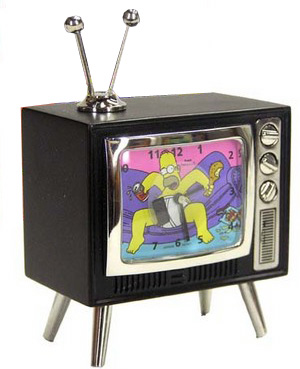
Office: HGH 210; phone: (408) 924-5378
Email: wooda@email.sjsu.edu
Web: http://www.sjsu.edu/faculty/wooda
 |
Dr. Andrew Wood Office: HGH 210; phone: (408) 924-5378 Email: wooda@email.sjsu.edu Web: http://www.sjsu.edu/faculty/wooda |
Gray, J. (2005). Television teaching: Parody, The Simpsons, and media literacy education. Critical Studies in Media Communication, 22(3), 223-238.
Note: These comments are not designed to "summarize" the reading. Rather, they are available to highlight key ideas that will emerge in our classroom discussion. As always, it's best to read the original text to gain full value from the course.
Gray argues that certain television
texts, such as The Simpsons, can be as useful a means to increase media
literacy as traditional education. Among several definitions, he suggests that
media literacy seeks to provide “to develop an awareness
of how media are constructed, by whom, and with which meanings privileged or
excluded, how consumers engage with them, and to what individual or societal
effects” (p. 224). Thereafter, Gray describes contemporary debates among
educators about their roles in the development of media literacy. Should they
“inoculate” students from the occasionally harm effects of media?
If so, how certain are we that they are without a trace of the same disease?
In contrast, some educators seek to employ media as part of the classroom, using
“students’ own experiences of and responses to media texts as a
touchstone for education” (p. 225). From that perspective, media texts
offer more than an opiate; they may reveal useful insight into students' worlds
and values. At this point, Gray turns to his notion that intertextual parody
found on some television shows can be as useful as they lessons of any media
literacy course.
 Intertextuality
refers to the idea that all signs are defined in relation to other signs. Thus,
we cannot know the meaning of a police officer’s badge without correlating
it to other signs such as a weapon and a uniform, not to mention cop shows and
other texts. Gray adds that intertext derives much of its meaning from genres
(or, in a broader sense, discourses, as Foucault would call
them). These provide containers of rules and expectations. For example, when
sampling from the genre of American “action-adventure” film, you
know you’ll generally see an explosion or gunshot. Putting these two concepts
together -- intertextuality and genre -- we watch a film starring an action
star and relate our experience of that film to previous action-adventure movies.
Of course, we expect the film to fit within its genre, and we might be disappointed
if it fails to do so. But some films that are ostensibly located within a certain
genre nonetheless manage to stretch our expectations of that genre. One way
this can happen is parody: “using the genre’s force against itself”
(p. 227). This may be termed critical intertextuality.
Intertextuality
refers to the idea that all signs are defined in relation to other signs. Thus,
we cannot know the meaning of a police officer’s badge without correlating
it to other signs such as a weapon and a uniform, not to mention cop shows and
other texts. Gray adds that intertext derives much of its meaning from genres
(or, in a broader sense, discourses, as Foucault would call
them). These provide containers of rules and expectations. For example, when
sampling from the genre of American “action-adventure” film, you
know you’ll generally see an explosion or gunshot. Putting these two concepts
together -- intertextuality and genre -- we watch a film starring an action
star and relate our experience of that film to previous action-adventure movies.
Of course, we expect the film to fit within its genre, and we might be disappointed
if it fails to do so. But some films that are ostensibly located within a certain
genre nonetheless manage to stretch our expectations of that genre. One way
this can happen is parody: “using the genre’s force against itself”
(p. 227). This may be termed critical intertextuality.
From this background, Gray turns to the heart of his analysis: advertisements
on The Simpsons. Among the strategies employed by the show, the author
focuses first on ironic juxtapositions, such as when the Catholic Church is
portrayed as re-branding itself in an absurdly sexual manner. Doing so, we recall
similar re-branding efforts in the real world and view them more critically
than we might have before seeing the episode. We also encounter Simpsons
episodes that mock the ethical compasses of advertisers (such as Krusty the
Clown) willing to do anything for a buck, and episodes that mock the “invasion”
of corporate sponsorship in all aspects of public and private life. Central
to Gray’s analysis is how The Simpsons reveals and ridicules
the manner in which advertisements are encoded, as well as their effect on presumably
passive viewers (eg., “Homie
the Clown”). Of course, Gray adds that even the Marxian critiques
of the media’s inoculatory power -- recalling the writings of Adorno --
are themselves ridiculed in that episode and throughout the show: no one is
as dumb as Homer. Gray concludes with a reminder that, despite its mocking tone,
The Simpsons rarely cuts too deep in its critique. Even so, we leave
the show with an appreciation for its many levels: high culture pastiche and
low-brow yucks. Somehow, The Simpsons manages to stay relevant after
all these years.
[Return to Syllabus]